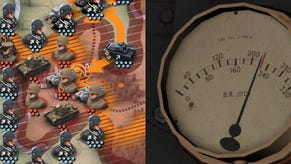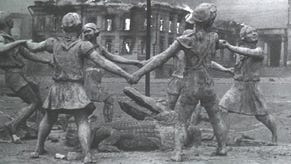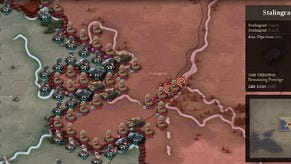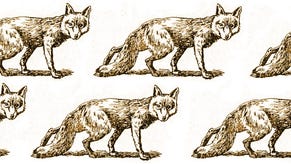The Flare Path: My Bloody Valentine
Simulation & wargame news
RPS likes to give the impression that it's one big happy family, but believe me, behind the scenes you can't move without tripping over a feud, a grudge, or a hefty hunk of personal enmity. Just this morning I pulled into the office car park and found the 'the team' bickering like battlefield vultures. It seems Mr. Grayson had parked his Ferdinand in the spot where Mr. Meer usually parks his KV-2 and when Mr. Rossignol intervened, Alec said something disparaging about Jim's Tsar Tank. When the arriving Mr. Smith's Tortoise 'accidentally' crushed Mr. Walker's T-27 tankette for the third time this month, the dispute really turned nasty.
I confess my first instinct was to take advantage of the smoke and confusion and put a couple of sly AP rounds into the flank of Rab Florence's Covenanter, but something about the scene framed in the gunner's scope of my spluttering Valentine (must get that carb looked at) caused me to remember I had more important work to do. I'd promised to contact 2x2 Games' Tomislav Uzelac about Road to Berlin, a recently announced adjunct for one of RPS' favourite wargames.
RPS: 'Road to Berlin'? I assume the road in question is the one that enters Berlin from the east not the west?
Tomislav: Correct. Road to Berlin (working title) is an expansion for Unity of Command that follows the story of how the Red Army transformed itself after the harsh lessons of 1941 and 1942.
RPS: Why did you take this particular road, and not, say, the road to Paris, Cairo, or Rome?
Tomislav: It's a period and theme that receives scant coverage in popular culture, and even then what you find usually revolves around German decision making. You may learn that attacking at Kursk was probably a bad idea for the Germans, or perhaps that an elastic defense would serve them better than hopelessly designating one 'fortress' city after another. What you won't get very often is the story of how the Red Army matured, by encouraging initiative and boldness among its officer corps; and by perfecting the "deep operation" - essentially the Soviet variant of the Blitzkrieg.
The Soviet campaign in the base game already shows you how the RKKA is a powerful, but still rather blunt instrument of war in early 1943. Players often report this to be a frustrating experience (and that sounds about right to me). Later-war Soviets are much more proficient, but this is very much offset by Stavka's ever growing ambition and an occasional sharp sting from the still dangerous Germans. If you're worried that it gets too easy, don't... this is Unity of Command, you will be tested.
As to why we didn't travel further afield, Unity of Command was designed with the Eastern Front in mind, so the emphasis is on things like maneuver and supply. In the West, the fighting was different, much more multi-dimensional in nature. Airpower played a much bigger role and there was also an extensive naval component that included numerous amphibious operations.
I'd like us to go there, but I believe it requires a bit of a rethink first. There are far fewer units in the West, which means more attention will be paid to individual combat outcomes. For that, I'm thinking about adding more specialist slots and fleshing out combat resolution slightly. Some sort of Fog of War mechanic, combined with decent intelligence briefings, would probably be a good idea too.
RPS: Are you still travelling light, rule-wise?
Tomislav: Still light. There may be some minor rule changes, but only what's necessary for the new scenarios to work. In fact, I'm holding off on making any changes before all of the planned scenarios are finished. Once we've played through everything we'll sit down, figure out what's the bare minimum needed, and put that into the game.
To give you some idea, one change we're discussing is to limit theater assets per-game, not just per-turn. This would make the use of bridging asset slightly more challenging in addition to our main purpose which would be to limit the maximum supply burst in some very long scenarios.
RPS: Have you had any mechanical problems/punctures en-route?
Tomislav: We had to make much more map and I found myself amazed at how unbelievably huge this country is. I know, Russia is the largest country in the world, but still... I can now appreciate this a whole lot better. What made it even more difficult is that the terrain in the original game was in large part featureless steppe - I believe I put the first version of that map together in a day or so.
In contrast, it recently took me that long just to navigate the labyrinth of lakes, forests and swamps around Leningrad. Finishing the entire map should add up to (totally unforeseen) three weeks or so - which should count as a puncture if I'm still with you on the metaphor.
RPS: (Apologies for the metaphor, but as it cost me £20 I will be using it for at least the next 4 questions) Have you picked up any hitchhikers since UoC's release, or is 2x2 still yourself (design, programming), Nenad (graphics) Ante (AI) and Bruno (sound)?
Tomislav: Indeed, we picked up some, and they're helping out with the expansion. We were able to do this is a result of the moderate commercial success we've enjoyed, so many thanks to everyone who bought the game.
RPS: Will the Road to Berlin have gentler inclines than the road to Stalingrad?
Tomislav: We didn't do any work on difficulty ramping for the original game, so already in the first scenario you're dropped into that rather sketchy situation with the Germans at 2nd Kharkov. I agree this is perhaps unnecessarily cruel, but I don't think we should be diluting the historical challenge for the sake of gameplay balance alone.
That said, I feel it's OK to give an extra turn or two for ordinary victory in the early scenarios of a campaign. Also, we can do things with prestige and what you get in the force pool, and between these two I think we can make the difficulty smoother without messing with the scenarios.
RPS: What road atlases did you read before setting out?
Tomislav: John Erickson's "Road to Berlin" for the narrative, and I also re-read Glantz's "When Titans Clashed" which I believe is the definitive introduction to the conflict. Unfortunately, the relevant volume (VIII) of the German official histories for this period is not yet available in translation, so we'll have to do without.
RPS: How far along the road to the Road to Berlin are you?
Tomislav: It's coming along nicely. We'll try to get it out the door in September or October this year if all goes well in the meantime.
RPS: Kübelwagen or jeep?
Tomislav: Undecided... or, let's pick the "Villis", just to be in keeping with the Soviet theme. But our favorite military vehicle of all time is of course the folding bicycle.
Interestingly, that photo looks remarkably like one of our MTB outings: men with facial hair lugging their bikes up a mountain. The Bersaglieri have better looking hats though, hands down.
RPS: Thank you for your time and your metaphor tolerance.
New Model Armies
Just across the road from my favourite Bordurian restaurant is a shabby little shop with a selection of stuffed owls in the window. To the lost tourist or the hurrying commuter, the place probably looks like an antiques emporium or taxidermy business. In fact, Savage & Son sell ideas. If you've got the cash, and Old Mr Savage likes the cut of your jib, a visit can be life-changing. Let me tell you about the last thing I bought from them.
I'd popped in for a shufti at the Computer Game Concepts section, and was grumbling about the lack of choice on the Simulation and Wargames shelf when Savage Senior suddenly raised an interjectory index finger. “Hold on a minute. We found something in the stockroom this morning that might be right up your street”. A few moments later he returned clutching a folder labelled 'KitSim'. “It's a peach Mr. Stone. Handled right, it could be Flight Simulator or RailWorks big.”
The old man's optimism seemed preposterous, but after thirty minutes with the musty dossier I understood his enthusiasm. In a nutshell, KitSim is plastic kit building on your PC. The satisfaction of turning a stack of sprue-suspended parts into a finely detailed AFV, aircraft, ship or auto; the challenge of painting, weathering and decal-ing your creation then arranging it within a pleasing diorama... KitSim will delivers all these things.
As the 'Potential Audience' page pointed out, the contemporary wargamer/simmer has - at present - very few outlets for creativity. Yes, if patient and committed he/she can fashion fuselages, rolling stock, routes or scenarios for cherished software, but such activities tend to be fiddly and frustrating - a means to an end. KitSim will make the construction process fun, intuitive, and accessible. Elaborate facsimiles of favourite vehicles can be fashioned by anyone that can follow a build diagram, or - if you choose to use the part-position highlighter - wield a mouse with a modicum of skill.
Which isn't to say there won't be numerous opportunities for artistry and self-expression. While the virtual nature of KitSim will mean you don't have to spend hours sanding and putty-filling poorly molded parts, producing subtle paint jobs with the virtual tools (airbrush, dry brush, smudger etc.) will inevitably require application. The KitSimmer that spends five minutes airbrushing their newly finished Tiger Tank all over with Dunkelgelb isn't going to produce as eye-catching a result as the one that spends an afternoon carefully applying Zimmerit and mud spatters, and delicately dabbing rust pigments and silver scrapes in likely spots.
Our best wargames and sims generate stories on the fly. Through its powerful diorama builder KitSim will let you tell your own tales. Sculpt a base, add scenic decoration, position vehicles, figures, debris... no two models will be the same. If you choose to, you can even enhance your tableau with optional background sounds, particle effects and animations. Serenaded by a Normandy blackbird, a wary Firefly commander scans the horizon with his fieldglasses... Reassured by the wail of nearby Nebelwerfers, a dusty Fallschirmjäger takes an occasional drag on his cigarette... Surrounded by flak flowers and ragged stratocumulus, a ravaged B-17 gamely limps home...
The page of suggested business models was missing from the folder, but I'm naturally drawn to the Flight Simulator model: periodic base-sim releases, full open architecture. Users would be given the tools to produce everything from decals and 'detail sets', to diorama bases and complete kits.
Hopefully an MSFS-style mod scene would develop with a range of professional payware producers co-existing alongside a bustling community of amateur artisans. Give it a few years and the KitSimmer should have a staggering range of models to choose from. Can't afford the latest Tamiya, Dragon or Wingnut Wings masterpiece? Not to worry, treat yourself to a digital equivalent at a fraction of the price.
KitSim, coming to Kickstarter page near you, soon*.
*Possibly.
The Flare Path Foxer
Scientific tests have proven that staring at great model box-art can be just as exciting as playing great PC wargames and simulations. In case of powercuts FP keeps a collection of collages like this one...
This week's stash of Flare Path Flair Points (8, brass, photo-etched) will be distributed amongst the defoxers that correctly identify the subjects and makers of the depicted kits.
























